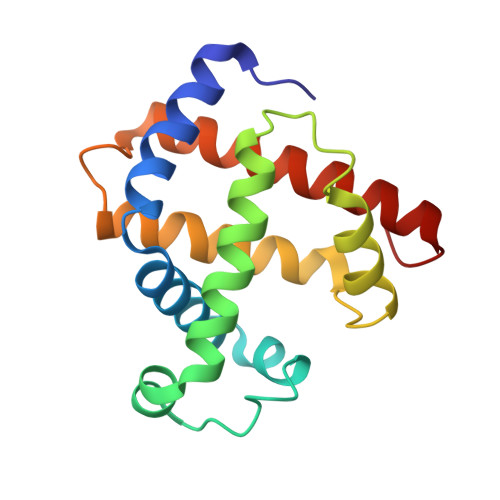High-resolution crystal structures of distal histidine mutants of sperm whale myoglobin.
Quillin, M.L., Arduini, R.M., Olson, J.S., Phillips Jr., G.N.(1993) J Mol Biol 234: 140-155
- PubMed: 8230194
- DOI: https://doi.org/10.1006/jmbi.1993.1569
- Primary Citation of Related Structures:
1MOB, 1MOC, 1MOD, 2MGA, 2MGB, 2MGC, 2MGD, 2MGE, 2MGF, 2MGG, 2MGH, 2MGI, 2MGJ, 2MGK, 2MGL, 2MGM - PubMed Abstract:
The highly conserved distal histidine residue (His64) of sperm whale myoglobin modulates the affinity of ligands. In an effort to fully characterize the effects of mutating residue 64, we have determined the high-resolution crystal structures of the Gly64, Val64, Leu64, Thr64 and Gln64 mutants in several liganded forms. Metmyoglobins with hydrophobic substitutions at residue 64 (Val64 and Leu64) lack a water molecule at the sixth coordination position, while those with polar amino acid residues at this position (wild-type and Gln64) retain a covalently bound water molecule. In the Thr64 mutant, the bound water position is only partially occupied. In contrast, mutating the distal histidine residue to glycine does not cause loss of the coordinated water molecule, because the hydrogen bond from the imidazole side-chain is replaced by one from a well-ordered solvent water molecule. Differences in water structure around the distal pocket are apparent also in the structures of deoxymyoglobin mutants. The water molecule that is hydrogen-bonded to the N epsilon atom of histidine 64 in wild-type deoxymyoglobin is not found in any of the position 64 mutant structures that were determined. Comparison of the carbonmonoxy structures of wild-type, Gly64, Leu64 and Gln64 myoglobins in the P6 crystal form shows that the conformation of the Fe-C-O complex is nearly linear and is independent of the identity of the amino acid residue at position 64. However, the effect of CO binding on the conformation of residue 64 is striking. Superposition of deoxy and carbonmonoxy structures reveals significant displacements of the residue 64 side-chain in the wild-type and Gln64 myoglobins, but no displacement in the Leu64 mutant. These detailed structural studies provide key insights into the mechanisms of ligand binding and discrimination in myoglobin.
Organizational Affiliation:
Department of Biochemistry and Cell Biology, Rice University, Houston, TX 77251.
















